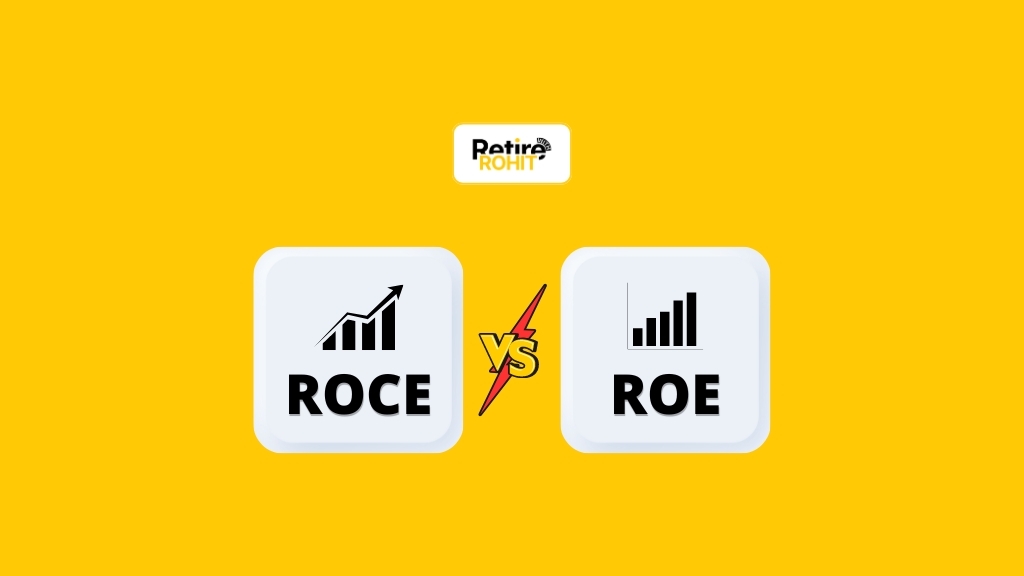What is ROCE Vs ROE in The Share Market?

If you're new to the stock market or just started investing, you've probably heard people say things like: "This company has a strong ROE!" or "Always check ROCE before buying a stock!" But what do these fancy terms actually mean? Don’t worry, this blog will explain ROCE vs ROE in the simplest way possible.
So what are ROCE and ROE? These are two basic but important financial ratios that help you understand:
- How profitable a company is
- How well it uses money (both borrowed and owned)
- Whether it’s a good investment or not
What is ROCE?
ROCE stands for Return on Capital Employed. It shows how well a company uses all the money it has, including its own money and borrowed money, to generate profit. While ROE focuses only on shareholder money, ROCE looks at the bigger picture: total funds used in the business.
ROCE Formula
The formula used to calculate the ROCE (Return on Capital Employed) is given below:-
ROCE = EBIT/ Capital Employed x 100
Where,
- ROCE - Return on Capital Employed
- EBIT - Earnings Before Interest & Taxes
- Capital Employed = Total Assets - Current Liabilities
Let’s say:
- Your friend starts a tea stall
- He puts ₹1,000 of his own money
- He also borrows ₹1,000 from someone
- So total capital used = ₹2,000
- After 1 year, he earns ₹200 profit (before interest and taxes)
ROCE = ₹200 / ₹2,000 × 100 = 10%
This means your friend generated a 10% return on all the money used (his + borrowed).
ROCE helps us judge overall business efficiency, not just returns to owners.
How to Calculate?
Let’s see the example, which helps you to understand, ROCE. And how it is used for analyzing and comparing companies.
Example 1: Company X
- EBIT (Operating Profit) = ₹60 crores
- Total Assets = ₹300 crores
- Current Liabilities = ₹100 crores
Now plug the values into the formula:
ROCE = EBIT/Capital Employed x 100
= 60 Crores/ (Total Assets - Current Liabilities) x 100
60 Crores/ (300 Crores - 100 Crores) x 100
60 Crores / 200 Crores x 100
= 30%
So, Company X has a ROCE of 30% for 2023.
Example 2: Company W
- EBIT = ₹200 crores (much higher than Company X)
- Total Assets = ₹600 crores
- Current Liabilities = ₹300 crores
Now let’s calculate:
ROCE = EBIT/Capital Employed x 100
= 200 Crores/ (Total Assets - Current Liabilities) x 100
200 Crores/ (600 Crores - 300 Crores) x 100
200 Crores / 300 Crores x 100
= 66.67%
So, Company W has a ROCE of 66.67% for 2023.
Company | EBIT (Cr) | Capital Employed (Cr) | ROCE(%) |
| Company X | 60 | 200 | 30% |
| Company W | 200 | 300 | 66.67% |
Even though Company W has higher profit, ROCE shows that it also uses its capital more efficiently. This means Company W is better at turning its money into profits. So if you’re comparing two companies, always look at ROCE, not just total profit.
What is ROE?
ROE stands for Return on Equity. It tells you how much profit a company earns from the money invested by its shareholders. In simple words, it shows how well the company is using your money (if you own shares).
ROE Formula:
The formula used to calculate the ROE (Return on Equity) is given below:-
ROE = (Net Income / Shareholders’ Equity) x 100
Where,
- ROE - Return on Equity
- Net Income - Total Revenue – Total Expenses
- Shareholders’ Equity = Total Assets - Total Liabilities
Let's say:
- You give your friend ₹1,000 to start a tea stall
- After 1 year, he earns ₹200 profit
- He didn’t take any loan, only used your money
ROE = ₹200 / ₹1,000 × 100 = 20%
This means your friend made a 20% return on your money. That’s a good use of your investment. In the same way, ROE tells you how smartly a company uses its shareholders’ funds to generate profit.
How to Calculate?
Let’s see an example, which will help you to understand ROE. And how it is used for analysis.
Example
Suppose that there is Company A has a shareholder’s equity of 6,000,000 Indian rupees and net income of 2,000,000 Indian rupees to determine:-
ROE = Net Income / Shareholders’ Equity
= 2,000,000/6,000,000
= 0.33
In the example above, Company A has a 33% ROE.
Difference Between ROCE vs ROE
Let’s see the difference between ROCE vs ROE.
| Basis for Comparison | ROCE | ROE |
| Concept | It measures how well a business can use capital to create more profits. | It measures how profitably and effectively an organization can generate profit from equity investment. |
| Full Form | Return on Capital Employed | Return on Equity |
| Components | Both equity financing and debt | Focus on equity capital |
| Formula | ROCE= EBIT(Earning Before Interest & Taxes)/Capital Employed | ROE = Net Income / Shareholders’ Equity |
| Considers | It considers the Operating Profit or Earnings Before Interest & Taxes (EBIT) | It considers the Net Profit or Profit After Tax (PAT) |
| Returns | Returns for Stakeholders (Equity+Debt) | Return for Equity Shareholder |
| Indication | High ROCE (Return on Capital Employed) can suggest better management of total capital. | High ROE (Return on Equity) can imply efficient use of equity. |
| Risk | ROCE doesn’t factor in Financial risk | ROE might indicate higher financial risk. |
Conclusion
In conclusion, both ROCE and ROE are important to understand a company’s financial health. ROE shows how well a company uses investor money, and on the other hand, ROCE shows how well a company uses all available money (including debt). So, which one is better? Use both. ROE gives you the shareholder view, and ROCE gives you the business view. Together, they help you decide if the company is truly strong or just pretending.


